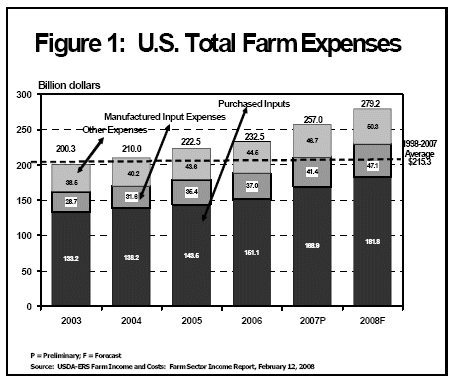AG-ECO NEWS
Vol. 24, Issue 6, March 11, 2008 – PDF version
Jose G. Peña
Texas AgriLife Extension Economist-Management
Record High Net Farm Income Forecast, But The Continuing Severe Drought in Southwest Texas Will Make 2008 A Difficult Year for Agriculture
U.S. net farm income in 2007 was a record high $88.7 billion and the year ended strong, with many key economic indicators at very favorable levels. USDA’s February 12, 2008, initial forecast of net farm income for 2008at a record $92.3 billion, is up $3.6 billion from 2007 and over $30 billion above the average of the last 10 years. The boost in 2008 U.S. farm income is primarily the result of high crop prices as well as above average prices for cattle,milk and other livestock and livestock products. On Monday (March 10, 2008) futures price bids for selected commodities/contracts settled at: July ‘08, KCBT Wheat (Kansas) at $11.65/bu; December ‘08, CBOT Corn at$5.79/bu; November ‘08, CBOT Soybeans at $13.00/bu; December ‘08, NYBOT Cotton #2 at $84.24/cwt; October‘08, CME Live Cattle at $101.18/cwt and October ‘08, CME Feeder Cattle at $111.33/cwt.
So, the agricultural economic outlook is about the best that it has been in over 50 years, but the continuing drought in a large portion of Texas, especially southwest Texas, may make it very difficult to capture some market opportunities unless significantly above average rainfall is received very soon. The soil profile is very dry and rain forecasts do not appear very optimistic, despite Monday’s rain. It is going to be difficult to plant crops, especially under dryland conditions. Forage availability is below average. It is going to be difficult to sustain livestock stocking rates and a continuing drought will have a serious effect on wildlife, which has become the economic lifeline for many ranching operations.
Production Costs Up
While the rise in commodity prices is boosting gross farm income, USDA-ERS February 12, 2008 forecast report indicated that U.S. production expenses in 2008 at$279.2 billion will be up $22.2 billion (8.6%) from 2007 and exceed a 10-year average by $63.9 billion. (See Figure 1). The estimate of U.S. production costs for 2008 are up $56.7billion (25.5%) from 2005, the year prior to the recent increase in energy cost. Meanwhile, direct government payments are expected to total $13.4 billion in 2008. While up $1.4 billion from 2007, this level of payments would beabout 30 percent below a ten-year (1998-2007) average of 17.4 billion.

While prices for commodities such as wheat, corn, soybeans are touching record highs and the market outlook for most other commodities is good, the current continuing severe drought and substantially increased production costs indicate that the agricultural sector is carrying substantially increased risks.
Crop Insurance
Producers should consider planting drought-tolerant crops, such as sorghum, and include crop insurance in their risk management plans. In terms of government subsidized crop insurance, indemnity prices for some policies,such as Crop Revenue Coverage (CRC), are established by futures prices. Since futures price bids are at or near record highs, estimates indicate that crop insurance indemnity price coverage will increase about 30 percent over last year. This means crop insurance may provide good financial risk management coverage. Since premiums may also be higher, producers should consider lowering their crop insurance percentage coverage levels. With higher indemnity prices, the same level of financial risk coverage as last year may be provided at a lower percentage coverage level and lower premium.
Drought
As measured in Uvalde, the last six months(September 6, 2007 to March 9, 2008) was the driest period on record with only 1.16 inches of total rainfall compared to a long term average of about 10.3 inches for the same period. (See Figure 2). While above average rainfall was received during spring/summer 2007, keep in mind that a lot of the rainfall was concentrated over short periods and a substantial amount was lost to run-off. But, even with higher spring/summer ‘07 rainfall, the southwest Texas region, which probably reflects the relative rainfall condition for a large portion of Texas, entered into drought conditions(75% of average six-month rainfall) in late January 2008.(See Figure 3). The current drought follows closely behind the drought of 2005-2006. The 17-month period fromNovember’05-to-March 27, 2007 was the driest period on record, with cumulative rainfall at about 45 percent of the long term average.

The moisture situation is critical and will require special plans to cope with the continuing drought.
Pastures and Ranges
In the final analysis, in terms of pastures and ranges, the real effect of any drought is its influence on vegetation and the vegetation’s capability to recover. To recover, the vegetation’s seed or rootstock must survive adrought. Seed/rootstock must be protected during periods of reduced rainfall, such as severely reducing grazing pressure. Recovery also requires abundant and timely rainfall. In addition to continued reduced stocking rates, significantly above average rainfall will be needed for several years to recover from the current drought. This appears unlikely, but even with above average rainfall it may be difficult to recover.
